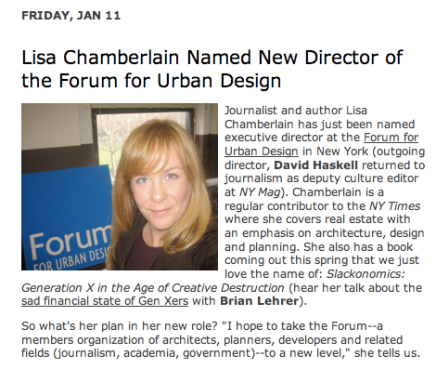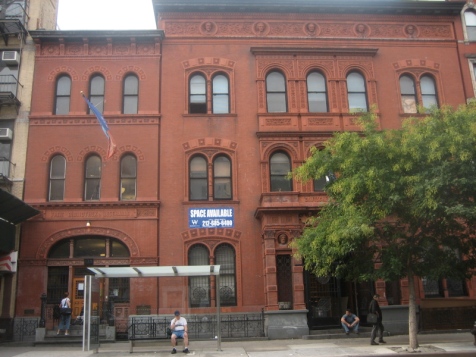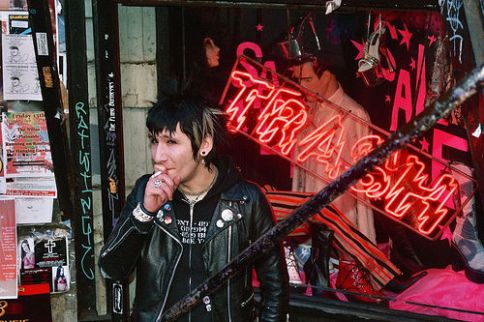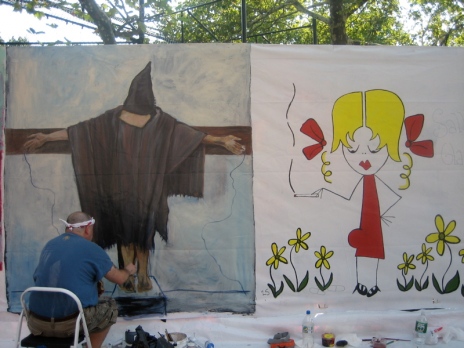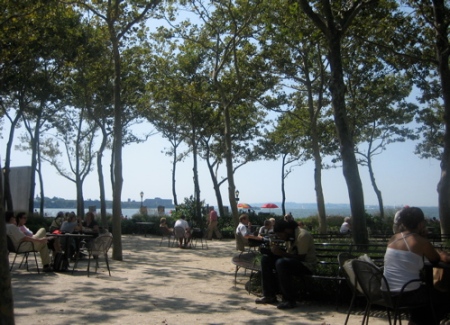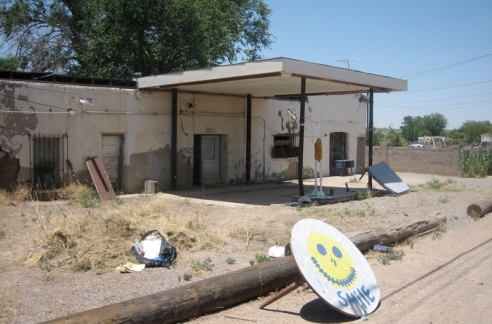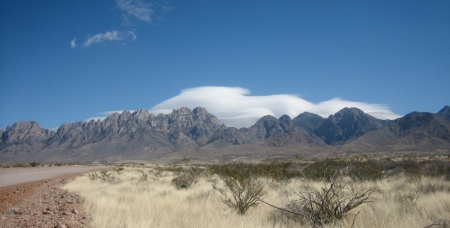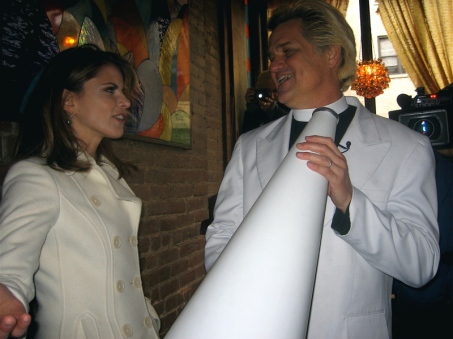Go to my new website to learn more about my new book, Slackonomics, to be published June 30, 2008.
New Post
January 12, 2008UPDATE! www.slackonomics.com is live!
I’ve been woefully negligent here on Polis. But UnBeige, a design-oriented blog on MediaBistro, has an update about what’s been happening in my life… To see the original post (with the weirdly distorted picture below), click here. I probably won’t revive Polis anytime soon, as I’ll be concentrating on developing a website for my book Slackonomics.
Boutique Hotel?
October 18, 2007I just noticed that one of the oldest and more important buildings in the East Village is up for sale. The Deutsches Dispensary, which up until very recently was the Stuyvesant Polyclinic, is under construction to become a temporary location site for a TV pilot called “Blue Blood,” a police drama. After that, who knows? I hate to say it, but it would probably be a cool boutique hotel…
The old Dispensary stands next to the slightly shorter and more narrow Freie Bibliotehek, the very first building ever erected in the United States specifically as a library. Both were designed by William Schickel and completed in 1884. The terra cotta facades are decorated with owls, globes and portraits of famous Germans (this used to be Little Deutschland).
These building details are hidden behind the tree in the pic above (click either one to enlarge):
Full Tilt E.Vil. Nostalgia
September 14, 2007Don’t miss The New York Times article about the best nabe in the world (still!), the East Village. The article mentions that Abbie Hoffman started the yippie movement in a basement apartment he lived in at 30 St. Marks Pl. I happen to live in one of two basement apartments that still exist at 30 St. Marks. The video (which is also excellent, don’t miss it) indicates that the “basement apartment” is now the Japanese restaurant Go, but I wonder if that’s correct, given that the restaurant is on the ground floor and there are still two basement apartments in the back. Does anyone know for sure which space Abbie Hoffman actually lived in? (I took the above photo in front of the store Trash and Vaudeville several years ago, which is the space where Yoko Ono and other artists held “happenings.”)
There is also a downloadable audio walking tour. Click here for that.
Howl Festival
September 8, 2007Tompkin Square Park is alive with the Howl Festival. I happened to catch The Little Death NYC featuring Moby this afternoon. The whole park was rocking. Along the outside fence are murals by local artists. Here is one of the more compelling juxtapositions (click to enlarge):
For a short slideshow of last year’s Howl parade down St. Mark’s Pl. at the end of the festival, click here and scroll down to the sixth item.
A New Era of Civic Virtue?
September 7, 2007The Chief Urban Designer for New York City, Alexandros Washburn, has a piece on Metropolis.com arguing that in previous centuries, civic virtue was expressed through architecture, from the Pantheon in Rome to the Farley building in New York. But the current era of civic virtue requires us to better manage the environment.
Nature is the new civic ideal. To invent the urban design language that will express this is a vital part of the mayor’s challenge. It may happen in surprisingly low-tech ways or it may take advantage of our most advanced science. It may build incrementally on tradition or it may seek entirely new forms. The only certainty is that change is in the air, from planting in our parking lots to rediscovering our waterfronts.
Chicago is, of course, way ahead of all other American cities in this regard, but the above picture is a good example of the issues we face here in New York. The largest green roof in the city is on top of Silvercup Studios in Long Island City, which benefited from some government support, but also required considerable private sector investment, most notably by Silvercup and the landscape architecture firm which designed the green roof, Balmori Associates. The firm recently won a design competition to do the landscaping around Gehry’s Bilboa Museum, and in fact, much of Balmori’s work — which is right in keeping with this new era of civic virtue — is not being done in New York City, where the firm is based, but in other international cities where there is a much greater commitment of resources to better managing the urban environment.
Herein lies the rub. A new era of civic virtue of environmental stewardship in cities across the United States (beyond Chicago) will require a serious commitment of government resources on the local, state and national levels. The modern interpretation of civic virtue on the scale of a Pantheon or Farely building requires nothing less.
Read the whole Metropolis article here.
For a Metropolis piece I wrote about Chicago in 2004, click here (PDF): metropolis-final.pdf
US Open
September 5, 2007I’ve been going to the US Open since 1990, the year Pete Sampras exploded onto the scene, beating Andre Agassi in what was supposed to be Agassi’s first grand slam title. This was also when Louis Armstrong Stadium was center court, before the monstrous Arthur Ashe stadium opened in 1997. I’ve only ever had seats in the nosebleed section of Ashe, which often provides better views of the Manhattan skyline than the tennis match. So take it from me, you haven’t seen tennis at Ashe until you’ve watched it from a luxury box, which I did last night until about 2:30 in the morning when David Ferrer beat Rafael Nadal. The velocity generated by the power-hitting of these two players just cannot be appreciated until you’ve seen it in person. Ferrer’s unbelievable defense is what ultimately won him the match. The pic above was taken just prior to the opening night matches, which started with Justine Henin and Serena Williams. (I gained a whole new appreciation for Henin’s game last night, who matched Serena’s power shot for shot, in addition to having more variety. Serena mistakenly seemed to think she could just muscle her way through, and ultimately failed because she never constructed points.) Alas, I’ll be back in the nosebleed section on Thursday.
Picnick
September 3, 2007The new food kiosk, Picknick, in Battery Park opened today, a beautiful day for a debut in Lower Manhattan. This eco-friendly food station (the seemingly plastic cups are made of cornstarch, among other recyclable items) is complimented by uncrowded tables, providing a great spot to see the harbor, Red Hook, and the Statue of Liberty.
Floating City
September 2, 2007I’m back in New York and I have a little story to share.
While I was in Mesilla, NM (see below), I was of course missing New York, but then not really — the beautiful adobe house I was staying in was huge and lovely, rundown in a charming kind of way, and ever so cheap (you see my point). So every morning, I biked a short distance to a coffee place, The Bean, and one day I noticed a book on one of the side tables, a slim little paperback titled, “Floating City,” which piqued my interest. It turned out to be a book of poems by a woman who had won the Walt Whitman award for new poets. Now, keep in mind I hardly ever read poetry, but I started reading this collection by Anne Pierson Wiese. Turns out she lives in Brooklyn and her poetry so absolutely captures the essence of life in the city — the small moments of beauty and tragedy, how the natural and the built environments can combine to create magic. So I kept this book with me (stole it from The Bean, I must admit), carrying it around in my bag for weeks, pulling it out at times to read a poem and just revel in this woman’s ability to remind me why I love New York so much. Here is one of my favorites:
Composed upon Brooklyn Bridge, July 6, 2003
How the city’s infinite motions seem stilled
in the sun’s horizontal blue gaze–her tips
and contraptions, her manifold upright lips’
lisp of steel and breath on sky, her curved sill
of shoreline, bridged and built as if the mills
of God have been replaced by quicker equipment,
her people heading home; now, before the dip
of the sun spills red, how this equal light wills
me to see the whole as one. For an instant,
her interlocking parts of bedrock and air,
asphalt and wind, metal and flesh, infant
cries of traffic and windows’ crowded state–
all these seem to pause and fuse, a jubilant
pair of mighty lungs with breath upheld in prayer.
Chelsea Hotel
July 29, 2007I’m still in Mesilla, NM (see below, or click here to go to a flickr page with photos of this historic southwestern town), but since I wrote an article for the Times about how the long-time managers of the Chelsea Hotel were ousted, and all the coverage this has received around the world, I thought I would repost the story I wrote more than a year ago about Living With Legends, the unofficial Chelsea Hotel blog (which has been covering the hell out of this ongoing tragedy). Below are links to two of the stories I’ve written for the Times about the Chelsea (both PDF files), and a photo essay I shot at the Living With Legends blog party that took place on April 28, 2006 in a room where Thomas Wolfe wrote, appropriately for a residential hotel, You Can’t Go Home Again.
A Year in the Life (Chelsea PDF)
Changes at the Chelsea, Shelter of the Arts (chelseafinal.pdf)
Living With Legends Blog Party (photo essay on flickr).
El Camino Real
June 10, 2007I took the day off from writing to bike along a historic trail called El Camino Real, picking it up in Mesilla, New Mexico and taking it almost all the way to El Paso, TX. This path was originally forged in 1598 by Don Juan de Onate, who was ordered by the King Philip II of Spain to colonize the upper Rio Grande, now known as New Mexico. The route Onate followed became El Camino Real, “the royal road,” which up until then only reached what is now Juarez. It’s a beautiful trip, and I took some pics along the way. Click to enlarge any photos.
Mesilla, New Mexico and taking it almost all the way to El Paso, TX. This path was originally forged in 1598 by Don Juan de Onate, who was ordered by the King Philip II of Spain to colonize the upper Rio Grande, now known as New Mexico. The route Onate followed became El Camino Real, “the royal road,” which up until then only reached what is now Juarez. It’s a beautiful trip, and I took some pics along the way. Click to enlarge any photos.
This was taken in of Mesilla (meh-SEE-uh, pop. 2,200), where many historic adobe homes and commercial buildings are still standing. Though Mesilla wasn’t founded until 1848, the area had long been the crossroads of the southwest until 1881 when Las Cruces (just a few miles east) offered free land to the Santa Fe Railroad, essentially freezing Mesilla in time (the historic square wasn’t paved as late as the 1970s). This turned out to be a good thing in terms of character and preservation. While the two places are separated only by railroad tracks, Las Cruces is a sprawling suburb while Mesilla is a historic, compact, walkable town.
The Mesilla Valley has long been an agricultural center, and further south along the El Camino Real, there are miles of pecan trees that shade the road, planted by W.J. Stahmann and his sons in the 1930s. Combined with land they purchased in Australia, this family became the largest pecan producer in the world. The climate is so dry that to water the trees, the ground is often flooded up to six inches, and as you bike underneath the canopy, you can feel a mist from the leaves perspiring.
I stopped at this overpass over the Rio Grande, which I’m told in the winter is completely dry from all the water being siphoned for agricultural uses. At first I didn’t notice the birds that were perched on a wire, but they noticed me, and began swirling about, as if to put on a show.
There are a couple of tiny little towns along this part of El Camino Real, mostly run down. This was taken in San Miguel, NM. But there is also a rich motorcycle culture here with a few lively hang-outs.
Last but not least, this was taken just south of La Mesa, with the Organ Mountains in the distance. The sad part is, El Camino Real is now on the National Trust for Historic Preservation’s list of most endangered places because of Richard Branson’s Spaceport, which is set to be built north of Las Cruces. According to the Trust, “El Camino Real is considered by many to be one of the largest and most important artifacts of the Spanish Colonial era in the United States and one of the most valuable single markers of the Hispanic experience in the Southwest.”
As a side note, also on the Trust’s list of endangered places are motels along Route 66, which I just wrote about for the Times (click here for a pdf route66final.pdf).
Polis will return to its usual gritty New York content in Sept.
Gone Writin’
May 9, 2007I will be in New Mexico for the entire summer finishing the book I’m writing, which was supposed to be done in February. I will have a nice view of the Organ Mountains (pictured above, click to enlarge) from the little bungalow where I’m staying. So don’t cry for me, New York City. See you in the Fall, with a new website and hopefully a big sense of relief.
Steel This Tree
April 24, 2007The New York City Park’s Dept. recently completed a two year study to determine the cost v. benefit of urban trees ($5.60 for every dollar spent). So what is the calculus for steel trees? The sculptor Roxy Paine has three steel trees being erected in Madison Square Park. Not much carbon dioxide being removed from the air, but they’re lovely to look at — and that cost benefit-analysis is even more difficult to calculate (click to enlarge photos).
being erected in Madison Square Park. Not much carbon dioxide being removed from the air, but they’re lovely to look at — and that cost benefit-analysis is even more difficult to calculate (click to enlarge photos).
Hudson Hotel Penthouse View
April 19, 2007The sun came out in NYC. This is the view from the penthouse of the Hudson Hotel.
Rev. Billy Ready for Close-Up
April 19, 2007So I’m toiling away at Mudspot, which I do nearly every day, when in comes Rev. Billy, founder of the Church of Stop Shopping, in full regalia, with Today Show correspondent Natalie Morales and a film crew in tow. Apparently, they have been shooting all over the E.Vil. for a segment to be aired in the not-too-distant future. While the Rev. Billy and his tent-revival mocking, anti-consumerist gospel may not be ready for primetime, he’s good to go for daytime.
Question from Morales to Mudspot owner Nina Berott: “Is Rev. Billy an activist or a crackpot?”
Laughter from the Mudspot regulars drowned out her answer, so tune into the Today Show to find out!
BTW: He may not be Tom Wolfe, but isn’t it kind of tacky for a reporter to wear a white suit while covering The Rev. Billy, who’s signature dress is a white suit, kinda like upstaging a bride by wearing a white gown? (Click to enlarge photo.)




 Posted by lisacchamberlain
Posted by lisacchamberlain 